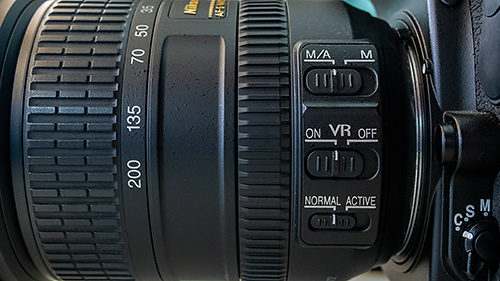Photo Corners headlinesarchivemikepasini.com
![]()
A S C R A P B O O K O F S O L U T I O N S F O R T H E P H O T O G R A P H E R
![]()
Enhancing the enjoyment of taking pictures with news that matters, features that entertain and images that delight. Published frequently.
Fixing a Nikkor Zoom



30 November 2022
An apparently common problem with the AF-S Nikkor 18-200mm f3.5-5.6 G ED zoom lens is that all of a sudden, when you press the Shutter button, the scene in the viewfinder hops up and back down before focusing.

This can be pretty unsettling, although it doesn't affect focal length or focus and, apparently, not image stabilization either. Which is a good thing because Nikon dSLR bodies do not provide image stabilization, which is only offered as vibration technology in its lenses.
The most recent quoted repair price we found was around $150 (plus shipping) a while ago. And a new lens is about $650.
FOCUS ISSUE
Focus and vibration reduction problems are issues best resolved by a repair service.
But some owners report a front element loosened by removing a filter, for example, can impair focus and easily be fixed by hand tightening it.
"With the lens mounted to the camera, hold the outer shroud and twist the lens element clockwise by the two slots on the outer ring," one owner described the solution.
Those slots are accessible when there's no filter covering the front element. A special wrench is available to engage them but you can finagle the lockdown ring without one.
CHATTERING ISSUE
Others have reported the lens makes a "chattering" noise. In the documentation accompanying the lens, Nikon warns:
Do not turn the camera power OFF or remove the lens from the camera while the vibration reduction mode is in operation. (Otherwise the lens may emit a chattering noise if the camera is shaken. This is not a malfunction. Turn the camera power ON again to correct this.)
It's easy to accidentally remove the lens with the power on unless you get in the habit of turning the power off immediately after taking a shot.
Making sure VR mode is not operating, in our case, means keeping our finger off the Shutter button.
JUMPING ISSUE
Our jumping issue is a bit different, though.
The jumping occurs when you change the scene but may not recur with minor adjustments to the scene where focus doesn't change, for example.
We read one interesting theory that this had to do with parking some elements of the VR lenses.
There were two approaches to resolving that issue:
- Wait for the meter display to turn off then turn off the camera.
- Turn off VR then turn off the camera.
We used a more elaborate approach, turning off VR and switching the Manual focus on the lens before turning the camera off and unmounting the lens.
We then remounted the lens, turned on Active VR and switched to M/A focus. We tried focusing on a few options around the room and experienced no jumping. We did the same thing on a second lens which had just started showing the problem and took it out for a walk. Again, no jumping as we shot a dozen shots around the neighborhood.
On the first lens, we did notice a small jump when we first powered up and focused although nothing afterward.
So we tried the first trick and let the meter display on the LCD time out before we turned off the camera. We heard a small thunk. When we turned the camera back on, we heard the thunk again but we didn't experience the jump at all. It seemed as if the lens was indeed parking the VR system.
CONCLUSION
We tend to turn the camera off without looking at the meter display when we think the image data has been written to the card. Not much of a delay. And, really, if the lens has to park itself, the camera should supply power until it does.
We wonder how long this bliss will last, though. We've asked Nikon to comment and if we learn anything or the problem recurs, we'll update this article.
Meanwhile we're very happy to have both lenses behaving themselves again.
Update (20 Dec.): The older lens is still behaving but the newer one (which is as old as the Nikon D300) reverted to three clunks on power up and down and jumping when you focus with a half-press. So we've sent it to Nikon for repair. It will be interesting to get a diagnosis. Our suspicion is that it's something to with the image stabilization system coming unmoored. That would explain the jumping viewfinder. The lens will arrive at Nikon in Long Beach on Thursday.
Update (10 Jan. 2023): See Repairing a Nikkor Zoom for the correct diagnosis and subsequent repair.